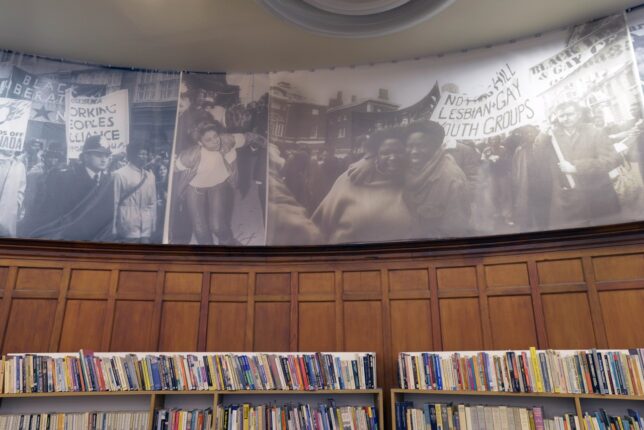Reviewed by Caroline.

When Carbon Slowly Turning, a new book that gives a stunning overview of artist and photographer Ingrid Pollard’s practice, spanning 40 years, arrived at Glasgow Women’s library I was both intrigued and excited. I relished the idea of revisiting work by an artist who we hosted at the GWL to produce the quite brilliant No Cover Up exhibition in 2021, which took inspiration from an extended period of research in The Lesbian archive. I was also intrigued by the title, it indicated straight away that however well I thought I knew Ingrid’s practice there were still hidden depths to explore.
The book started in what I felt was familiar territory with an essay by Paul Gilroy, which brilliantly set the context for the protest themes that emerged in No Cover Up. Themes that as Gilroy astutely acknowledges were part of Ingrid’s own life, as one of thousands of demonstrators who felt compelled to speak up against the heady combination of police brutality and denial that accompanied the racist subtexts of Thatcher’s ‘Great’ Britain. Gilroy brings us right up to date as he describes the ‘unseasonal summer of 2021’ and I felt delivered back to Ingrid’s GWL in that year where her work hit home just how much hadn’t changed, quietly showing us the long view. Yet also creating works that provided hope through an animated archive of voices; interviews with activist survivors whose photos populate our archive and still have inspirational stories to tell.
Gilroy’s insight into works like Hidden histories, Heritage Stories (1994) and Ingrid’s extensive documentation of signs in those landscapes, simultaneously revealing racist and black histories, also brought me back to the post-industrial landscapes I had grown up in the South east of England. Yet this time my memories were accompanied by Ingrid as a companion to my white council estate upbringing, showing me hidden histories in plain sight.
The next essay by Anna Arabindan-Kesson explored Ingrid’s life-long engagement with landscape through her unpicking of what appear as quintessentially English landscapes, including the borders of places, with coastal edges featuring extensively. Here colonial histories are brought into relationship with the complexities of contemporary belonging and identity in Ingrid’s work. Araindian-Kesson (I have used first names where I know the writers and artists but otherwise as here I’m using her surname) mentions she has had a long relationship with Ingrid’s photographic practice. This feels important to me. That the artworks I see are about many things, all at once, and the collected essays reflect this depth and complexity and do a good job of surveying many more works than I can write about here. If I had to pick one word out though it might be the word relationship. In her works Ingrid draws relationships between multiple histories and the present moment, between image and text and between bodies and space.
Mason Leaver-Yap also writes about Ingrid’s exploration of relationships. Focusing the essay on the small gesture of the curtesy Mason reveals a whole repertoire of power and control portrayed in Ingrid’s work that can be seen in the rituals that we carry with us and reinvent for new moments. Here we also see the diversity of forms Ingrid uses and where research, this time at the British film Institute, where she unearths a propaganda film by made by the Colonial Film Unit, is transformed into surprising creative responses, including the incredible sculptural works, Bow Down Very Low – 123 (2021) made in collaboration with kinetic artist Oliver Smart. While Mason’s focus is on unequal relationships revealed by Ingrid’s work their essay also reveals a friendship, with many quotes coming from conversational moments between them. I see this too in the banner Ingrid made for the GWL, Demo frieze (2021). Surrounded again by depictions of bodies bundled into police cars, or expressions and placards set in resistance, there is a photo of a woman smiling at a protest. When we unwrapped this section of the banner Ingrid commented on that expression between person and camera – which is actually between two friends engaged in collective struggle. I’m returned to the second essay where Arabindan-Kesson reveals her own life-long engagement with Ingrid’s photographs, which, possibly like friendships, demand a more careful look at taken for granted things and a return, with understanding growing over time.
This is what the book encourages too. As I read I learn much more about Ingrid’s work. Cheryl Finlay’s contribution interweaves knowledge of the multiple technical practices Ingrid developed, from the use of the Claud Glass to hand tinting and reworking of the French textile technique Toile de Jouy, to express her themes, alongside her personal and professional experiences working in vital community spaces like Lenthall Road Workshop and for feminist organisations like Outwrite newspaper and Spare rib, where she worked on layouts for publications which provided a vital alternative voice. I’m excited to think of the ‘burgeoning Black art scene of the 1980s’ that Ingrid experienced, populated by Bernardine Evaristo’s experiments in community theatre and visits from Maya Angelou, and developed work out of. I’m also encouraged to look back as I move through the book. With all the image credits in the back pages I increasingly feel the need to return and look again as I keep reading. Carbon slowly turning.
The book ends with a series of poetic responses by Gilane Tawadros as well as stunning portraits, some of performers, reminding us that the creatively we have witnessed in this brilliant book is both shared and contagious. By being in relationship we leave behind a multitude of traces that run deep, and definitely require a long look back, if we are to learn to find different ways to inhabit and cohabit shared landscapes.

Comments are closed.